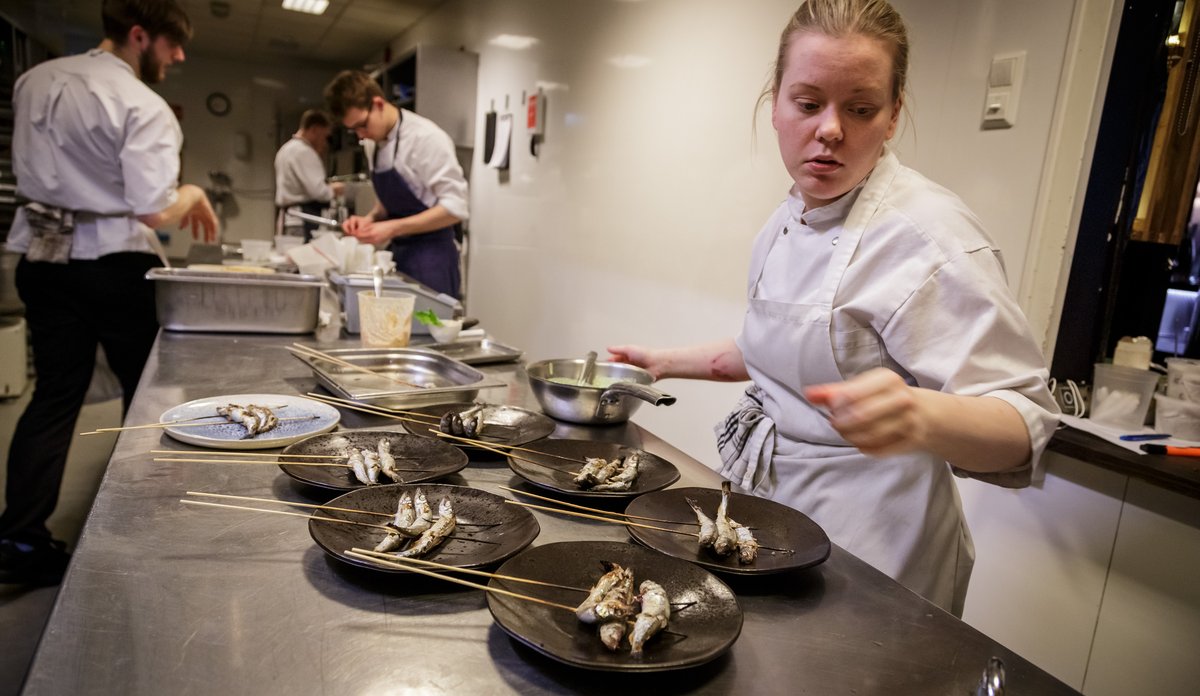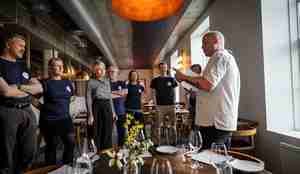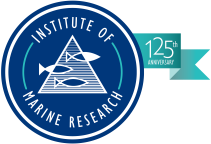Successful takeover puts capelin and warrior shrimps on the menu

Heil rognlodde frå forskingstokt i Barentshavet blei éi av stjernene på menyen.
Photo: Erlend A. Lorentzen / Havforskningsinstituttet
Serving food 101
Photo: Erlend A. Lorentzen / Institute of Marine Research
The drink of the evening contained dried lobster and kelp.
Photo: Erlend A. Lorentzen / Institute of Marine Research
Øystein Sæle and head chef Christopher Haatuft are taking orders.
Photo: Erlend A. Lorentzen / Institute of Marine Research
Researchers plus head chef were personally gone fishing the day before the event. They caught local saithe which were killed and treated with the japanese technique of ikejime. By destroying the sentral nervous system, the dead fish will relax completely. The lack of spasms will prevent lactic acid from reaching the filet, resulting in brilliant sashimi.
Photo: Erlend A. Lorentzen / Institute of Marine Research
Marinated red sea cucumber.
Photo: Erlend A. Lorentzen / Institute of Marine Research
Bycatch: Local grey gurnard, John Dory and warrior shrimps from the Barents sea.
Photo: Erlend A. Lorentzen / Institute of Marine Research
Researcher Martin Wiech is serving red sea cucumber.
Photo: Erlend A. Lorentzen / Institute of Marine Research
Managing IMR Director Sissel Rogne was part of the team of food loving, and serving, scientists.
Photo: Erlend A. Lorentzen / Institute of Marine Research
John Dory and Barents sea warrior shrimp over hot charcoal.
Photo: Erlend A. Lorentzen / Institute of Marine Research
Whole roe capelin from a research cruise.
Photo: Erlend A. Lorentzen / Havforskningsinstituttet
Roe capelin from the Barents sea.
Photo: Erlend A. Lorentzen / Institute of Marine Research
Stein Mortensen is an amateur at serving food, but an expert in oysters and mussels.
Photo: Erlend A. Lorentzen / Institute of Marine Research
Scientist Øystein Sæle worked as a waiter during his days of studying and were able to impress the guests with more than academic knowledge.
Photo: Erlend A. Lorentzen / Institute of Marine Research
Panserrekene fekk bein å gå på.
Photo: Erlend A. Lorentzen / Havforskningsinstituttet

Warrior shrimp over hot charcoal.
Photo: Erlend A. Lorentzen / Institute of Marine Research
The John Dory were fileted by experts in fish anatomy.
Photo: Erlend A. Lorentzen / Institute of Marine Research
Saith sashimi and warrior shrimp.
Photo: Erlend A. Lorentzen / Institute of Marine Research
Head chef Christopher Haatuft is also known as the "punk rock chef".
Photo: Erlend A. Lorentzen / Institute of Marine ResearchPublished: 05.04.2019 Updated: 06.08.2021
“Or at any rate we took over the menu. The chef’s knife and garnish tongs remained safely in the hands of the chefs”, explains the man behind the idea, marine scientist and food nerd Arne Duinker.
Together with head chef Christopher Haatuft, a team of food-loving marine scientists selected raw ingredients from the sea that are either unknown to most people, or not normally eaten for other reasons.
Strange bivalves and bycatches, potent sea cucumbers, capelin from research catches, ikejime saithe and warrior shrimps all featured on the highly unusual menu served at Lysverket.
"An unadventurous seafood nation"
“We keep talking about discovering the foods of the future. We wanted to show the people of Bergen that there are already plenty of new, sustainable food types out there”, says Duinker.
He feels that for being one of the world’s leading seafood nations, Norwegians are unadventurous in their attitude towards seafood.
“Norwegians need to open their eyes to all of the fantastic things swimming around and growing just below the quayside”, says Duinker, who personally likes to sample everything he encounters in the watery element.
See our opinion piece in Norwegian: – Hva med tare til fredagstacoen? [Anyone for a kelp taco?]
“So far, the only thing I’d strongly recommend against eating is a rabbit fish.”
The Institute of Marine Research also does food
Havforskingsinstituttet jobbar med mat langs fleire spor: Nye oppdrettsartar, skjel, nye fiskeri, utnytting av råstoff og kva som er sunt og trygt.
The Institute of Marine Research’s work involves looking at food in a variety of ways: at new species for aquaculture, at molluscs, at new fisheries, at how to exploit resources and at what is healthy and safe to eat.
“The emergence of a new Norwegian food culture may help us to become more self-sufficient, and give our seafood industry more strings to its bow”, explains Duinker.
We also work on food security, on ensuring there’s enough food for everyone. Sissel Rogne, the Director of the IMR, also acted as a fish sommelier for the night, and she highlights this as one of the important reasons for organising the event.
“In 2016, 815 million people in the world were chronically undernourished. That’s one of the many reasons we’re so interested in both discovering and rediscovering sources of food”, says Rogne.
Reinventing Norwegian food culture
The guests who attended the event were served food by scientists who were very happy to share their knowledge about the raw ingredients and their origins — as well as the odd old wives’ tale.
There is a suspiciously big overlap between the researchers’ interests and the latest trends in culinary philosophy.
“What would we eat if we had to invent a food culture from scratch, using what is available to us?
That’s the concept behind neo-Nordic cuisine”, explains Lysverket’s head chef Christopher Haatuft.
He is credited with coining the phrase “neo-fjordic cuisine” as a Norwegian answer to “neo-Nordic cuisine”.
May lead to a culinary partnership
Lysverket is one of the most respected restaurants in Bergen.
Not everyone may be able to splash out on a fine dining tasting menu on a Thursday evening out. But Haatuft also offered more affordable a la carte dishes and bar snacks, with a bit of research thrown in.
“The tasting menu was where we really wanted to demonstrate that it’s possible to make sought-after delicacies from unsought-after or unknown raw ingredients”, concludes Haatuft.
Perhaps this collaboration will lead to something more.
